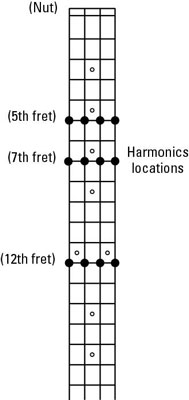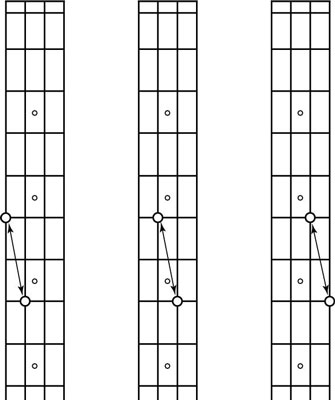Harmonics are notes that sound naturally on a string when you lightly touch it at certain points on the bass guitar and then strike it with your right hand. Because the bass strings sound so low, the higher harmonics are much easier to hear. The strongest and clearest harmonics can be found at the 12th fret, the 7th fret, and the 5th fret.

The sounds of the harmonics are crystal clear, which makes them a great tuning tool. However, to use the harmonics, you must first develop a solid technique for making them ring. To play harmonics, follow these steps:
Lightly touch the desired string at the 12th, 7th, or 5th fret with one of the fingers on your left hand (the middle or index finger is best, but any will do).
Don't press the string to the fret, and make sure only one finger is touching the string. Leaving your left-hand finger resting on the contact point (12th, 7th, or 5th fret), strike the string with your right hand.
Place your right hand close to the bridge and strike the string (that you're touching with your left hand) with either the index or middle finger of your right hand.
The closer your striking (right-hand) finger is to the bridge, the clearer your harmonic will be.
When the harmonic rings out, you can remove your left-hand finger from the string.
The harmonic will continue to ring out as long as you don't touch the string.
The harmonics tuning method is the most difficult and most precise tuning method you can use to tune your bass without a tuner. But if you follow these steps, you'll quickly get the hang of tuning your bass to itself using harmonics.
Using the pinkie of your left hand, lightly touch the tuned G string at the 7th fret. (The G string should already be tuned to an outside reference source.)
Strike the string and let it ring. This sounds the harmonic.
Using the middle finger of your left hand, lightly touch the D string at the 5th fret.
Strike the harmonic and let it ring together with the previous harmonic. Adjust the tuning head of the D string until the wavering stops.
Using the pinkie of your left hand, lightly touch the D string at the 7th fret.
Strike the harmonic and let it ring.
Using the middle finger of your left hand, lightly touch the A string at the 5th fret.
Strike the harmonic and let it ring together with the previous harmonic. Adjust the tuning head of the A string until the wavering stops.
Using the pinkie of your left hand, lightly touch the tuned A string at the 7th fret.
Strike the harmonic and let it ring.
Using the middle finger of your left hand, lightly touch the E string at the 5th fret.
Strike the harmonic and let it ring together with the previous harmonic. Adjust the tuning head of the E string until the wavering stops.

The following list gives you the most important harmonics for tuning:
The 7th-fret harmonic on the G string (the thinnest string) is exactly the same note as the 5th-fret harmonic on the D string (the second-skinniest string).
The 7th-fret harmonic on the D string is exactly the same note as the 5th-fret harmonic on the A string (the second-thickest string).
The 7th-fret harmonic on the A string is exactly the same note as the 5th-fret harmonic on the E string (the thickest string).
Most of the notes that are offered to you as reference pitches (such as from a guitar) are in a higher octave. If you tried to match the higher note exactly, the string you're tuning would snap and whip around your ears. Comparing notes that are an octave (or two) apart is easiest using harmonics.
When you strike a harmonic on a string that isn't in perfect tune, you can hear a beating or wavering sound. Let the harmonics ring, and slowly turn the tuning head of the string you're trying to tune. If the wavering gets faster, you're turning in the wrong direction. If the wavering gets slower, you're turning in the correct direction. Turn the tuning head until the wavering stops.
When the tone is even, your string is in tune. If the wavering gets slower and then speeds up again, you've turned the tuning head past the correct pitch. In this case, slowly turn the tuning head in the other direction until the wavering stops.

